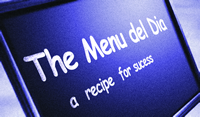|
Being a food connoisseur, or “being greedy” as my wife would say, food is very important to me. Over breakfast I need to know what, and if we are pushing the boat out, where we will be eating that day.There is a lot of conventional wisdom associated with food. Here are two for example; food in Britain is rubbish and the best food in the world is in France. |
 |
However, a survey released in September this year stated that London was the most expensive city ion the world to eat.
The best restaurant to eat in London was chosen as Chez Bruce, knocking last year’s winner Gordon Ramsay off the top spot. I have eaten at Chez Bruce and agree it is excellent. So what about France, well Spain is now snapping at their heels and is the midst of a “dynamic food revolution” with chef’s such as Ferran Adrià and Quique Dacosta (the self-taught chef who has just earned a second Michelin star) recently holding master classes in the USA demonstrating the whys and wherefores of Spanish cuisine to old hands such as Anthony Bourdain. If you are also a foody Bourdain’s book “Kitchen Confidential: Adventures in the Culinary Underbelly” is highly recommended.
Well then, so much for conventional wisdom, which was described as “what most closely accords with self-interest and personal well-being or promises best to avoid awkward effort or unwelcome dislocation of life” by the economist John Kenneth Galbraith. So conventional wisdom is the type of fact that is easy and convenient to believe in a “bloke down the pub told me” or “I read it in the Sun newspaper” kind of way.
It was one of these discussions in fact that lead to this article. We all agreed in a bar recently that the Menu del Dia in Spain existed by law to give people on lower incomes a low-cost, three-course meal. Nonetheless, following some internet-based research, this would not appear to be the case. In one article I read, a number of Spanish embassies were asked if such a law existed. A reply came from the Spanish Embassy in New York that the concept of the Menu was to provide low-cost food for tourists and was conceived in the 1960’s. Although this does make some sense, from a business point of view it does not. This might explain why some bars do not advertise their Menu del Dia. But if you ask the waiter he or she will tell you what is available. For anybody reading this that has not seen or tried a Menu del Dia, the menu itself usually comprises of three starters (Primero), three main courses (Segundo) and three desserts (Postre). So not a huge choice, but in my experience the food is normally excellent and is often a very good and inexpensive way to try some local Spanish food. Is it just me or does food taste better when it is free or cheap?
Last year in a bar in la Herradura I was enjoying the second course of my Menu del Dia. I cut into my baked potato and put it into my mouth, began to chew and found it to be crunchy. I inspected the skin of the potato and found it to be covered in mud. Here are three reasons why I did not complain. 1) I am British. 2) Maybe it was supposed to be like that. 3) At 7.50 € it was still an excellent meal despite the mud!
So whilst you can spend a fortune on a high-cost meal in London (or probably any city in the world for that matter) the Spanish Menu del Dia proves that you can also eat well for next to nothing in Spain. And don’t let my muddy potato put you off.
Andy Wilkes – Competa



















